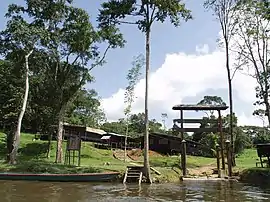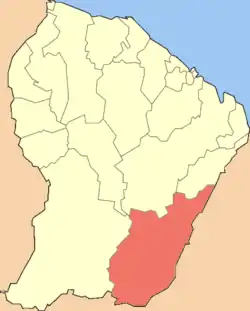Camopi
Camopi is a commune of French Guiana, an overseas region and department of France located in South America. Camopi is mainly inhabited by Amerindians of the Wayampi and Teko tribes.[3]
Camopi | |
|---|---|
 Entrance to the Camopi encampment of the 3rd Foreign Infantry Regiment | |
 Location of the commune (in red) within French Guiana | |
Location of Camopi 
| |
| Coordinates: 3°09′56″N 52°20′28″W | |
| Country | France |
| Overseas region and department | French Guiana |
| Arrondissement | Cayenne |
| Intercommunality | Est Guyanais |
| Government | |
| • Mayor (2020–2026) | Laurent Yawalou[1] |
| Area 1 | 10,030 km2 (3,870 sq mi) |
| Population (2017-01-01)[2] | 1,805 |
| • Density | 0.18/km2 (0.47/sq mi) |
| Time zone | UTC−03:00 |
| INSEE/Postal code | 97356 /97330 |
| 1 French Land Register data, which excludes lakes, ponds, glaciers > 1 km2 (0.386 sq mi or 247 acres) and river estuaries. | |
History
In 1738, a Jesuit mission opened on the Oyapock River near the current town of Camopi. The missionaries brought European diseases and caused a depopulation. In 1763, the Jesuits left and most of the population dispersed.[3]
During the 18th and 19th century, the Teko had moved into the area which had been home to the Wayampi, and by the 1830s, their territories overlap, however the tribes remained isolated.[4] In 1930s, France and Brasil renewed their interest in the area, and wanted to establish borders.[5] Medical facilities were established in the mid-1950s followed by a school. In the 1960s attempts were made to group the population into bigger villages with limited success. A granman (paramount chief) was installed according to the Maroon hierarchy, but failed to catch on.[6]
In 1969, the town of Camopi was established. Parts of the tribes rejected the modernisations, and in 1970 access to the commune had been restricted.[7] In 1987, Jacques Chirac as Prime Minister had established Zones of Collective Use Rights (ZDUC).[8] ZDUC means that the villages have communal land for hunting, fishing, agriculture and gathering.[9]
In the late 1980s, gold had been discovered around the Camopi River. Illegal gold miners have moved into area, and villages of Vila Brasil and Ilha Bela had been established opposite the town of Camopi on the other side of the Oyapock River.[10] The 3rd Foreign Infantry Regiment has set up a camp to protect the border.[11] Even though Vila Brasil had been built illegally in a nature reserve, Brazil designated Vila Brasil as a district of the municipality in 2011.[10] In 2013, the access to the village of Camopi was no longer restricted, and the town had slowly opened for tourism.[3] The southern village cluster of Trois Sauts still requires a special permit from the Prefecture.[12] In the early 21st century, the Amerindians started to built hamlets with subsistence farms several kilometres from the town of Camopi. By 2010, there were 45 hamlets, and most had left the main town.[13]
Geography
With a land area of 10,030 km2 (3,870 sq mi), it is the third-largest commune of France.[14]
The village of Camopi, seat of the commune, lies on the border with Brazil at the confluence of the Camopi River into the Oyapock River.
The commune can only be reached by boat or via the air.[11] It is served by Camopi Airport.[15]
Villages
See also
References
- "Répertoire national des élus: les maires". data.gouv.fr, Plateforme ouverte des données publiques françaises (in French). 2 December 2020. Retrieved 7 December 2020.
- "Populations légales 2017". INSEE. Retrieved 6 January 2020.
- "Guide Camopi". Petit Futé (in French). Retrieved 3 June 2020.
- Davy & Tritsch 2012, p. 5.
- Davy & Tritsch 2012, p. 7.
- Davy & Tritsch 2012, p. 9.
- Davy & Tritsch 2012, p. 10.
- "Un atlas des Zones de droits d'usage collectifs en Guyane". journals.openedition.org (in French). 2014. Retrieved 31 May 2020.
- "Les zones de droit d'usage des Amérindiens : comprendre les attributions du foncier pour mieux le gérer (1/2)". France la Première (in French). Retrieved 31 May 2020.
- Davy & Tritsch 2012, p. 13.
- "Camopi: visite de Camopi en Guayne". America FR (in French). Retrieved 3 June 2020.
- "Musiques et danses Wayampi". Une Saison en Guyane (in French). Retrieved 1 August 2020.
- Davy & Tritsch 2012, p. 16.
- "Villes de plus grande taille, superficie, surface - toutes-les-villes". Toutes les Villes via Archive.org (in French). 2013. Archived from the original on 2013-03-02. Retrieved 3 June 2020.
- "Vila Brasil Airport". Airport Guide. Retrieved 3 June 2020.
Bibliography
- Davy, Damien; Tritsch, Isabelle (2012). "Construction et restructuration territoriale chez les Wayãpi et Teko de la commune de Camopi, Guyane française". Research Gate (in French).CS1 maint: ref=harv (link)